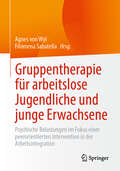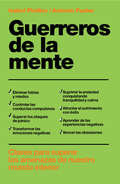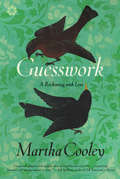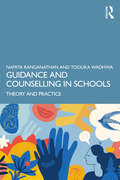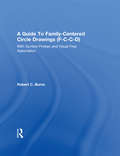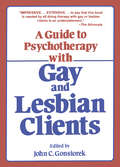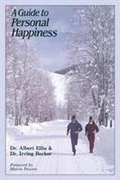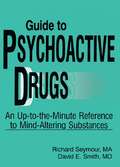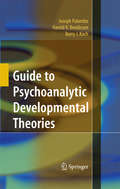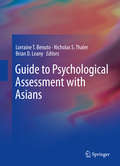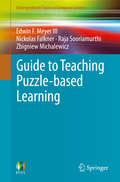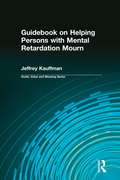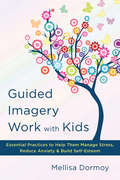- Table View
- List View
Gruppenpsychotherapie
by Bernhard Strauß Dankwart MattkeGruppenpsychotherapie ist eine anerkannte Methode der Anwendung aller wichtigen Psychotherapieverfahren, das die in einer Gruppe auftretenden speziellen Gruppenphänomene für die Psychotherapie einsetzt. Sie findet Einsatz im ambulanten, teilstationären und stationären Setting und dient auch als Unterstützung bei vielfältigen psychosozialen Konfliktfeldern. Dieses Buch versteht sich als Lehrbuch für die Praxis: Fachleute aus den jeweiligen Anwendungsfeldern stellen die relevanten theoretischen Informationen und Handlungsempfehlungen für die Arbeit in verschiedenen Settings und bei den Störungsbildern dar.
Gruppentherapie für arbeitslose Jugendliche und junge Erwachsene: Psychische Belastungen im Fokus einer peerorientierten Intervention in der Arbeitsintegration
by Filomena Sabatella Agnes Von WylDieses Buch befasst sich mit den psychischen Belastungen von Jugendlichen und jungen Erwachsenen in Arbeitslosigkeit. Junge Arbeitslose sind häufiger psychisch belastet als ihre Peers. Gleichzeitig gehören sie zur Altersgruppe, die am wenigsten professionelle Hilfe sucht, wenn ihre psychische Gesundheit beeinträchtigt ist. Die Herausgeberinnen verfolgen einen innovativen Ansatz, in dem sie ein niederschwelliges therapeutisches Gruppenangebot dort implementieren, wo sich junge arbeitslose Erwachsene aufhalten: in der Arbeitsintegration. In der Schweiz wurde ein gruppentherapeutisches Angebot in arbeitsintegrativen Maßnahmen für Jugendliche implementiert. Dabei wurden Therapeuten und Therapeutinnen eingesetzt, die einerseits die Gruppentherapie leiteten aber auch den Fachpersonen in den Angeboten Unterstützung anboten in Form von Supervision. Dieses Buch soll auch aufzeigen, wie Gruppenpsychotherapie in neuen, nicht klinischen Settings gelingen kann und auf was geachtet werden muss. Nebst den Hintergründen des Projekts wird das therapeutische Konzept sowie dessen praktische Umsetzung ausführlich vorgestellt inkl. Erfahrungen, Stolpersteine und Hinweise, worauf man als Fachperson achten sollte.
Guerreros de la mente
by Isabel Pinillos Antonio Fuster¿Quién no tiene o conoce a alguien que sufra ansiedad, algún tipo de fobia, ataques de pánico, temores infundados o miedo extremo? En nuestra sociedad, estos tipos de trastornos están cada vez más generalizados. Los guerreos de la mente nos enseña cómo funcionan sus mecanismos y cómo luchar contra ellos. Isabel Pinillos y Antonio Fuster nos explican el significado de las defensas que creamos en nuestra psique desde nuestra infancia. Muchos de los problemas psicológicos que sufrimos tienen que ver con episodios del pasado en los que nos sentimos en peligro y tuvimos que elaborar un tipo de defensa. Con el paso del tiempo, esta sigue respondiendo reiteradamente como si estuviéramos viviendo ese riesgo una y otra vez aunque ya no exista. Estos "guerreros" nos impiden vivir satisfactoriamente, pero a través de estas páginas lograremos identificar el origen de esos mecanismos, cómo funcionan, sus disfraces y también cómo reeducarlos y ubicarlos en el lugar que les corresponde. Un libro serio y riguroso, fruto de más de veinte años de experiencia clínica de la psicóloga Isabel Pinillos y con la colaboración del periodista y estudioso de temas psicológicos Antonio Fuster. Contiene ejercicios prácticos que bien realizados son de gran ayuda en personas con problemas de esta índole.
Guerreros de la mente: Claves para superar las amenazas de nuestro mundo interior
by Isabel Pinillos Antonio FusterQué son, cómo se originan y cómo combatir las resistencias y defensas psíquicas, desde la ansiedad y el pánico a las fobias. ¿Quién no tiene o conoce a alguien que sufra ansiedad, algún tipo de fobia, ataques de pánico, temores infundados o miedo extremo? En nuestra sociedad, este tipo de trastornos están cada vez más generalizados. Los «guerreros de la mente» nos enseñan cómo funcionan sus mecanismos y cómo luchar contra ellos. Isabel Pinillos y Antonio Fuster nos explican el significado de las defensas que creamos en nuestra psique desde nuestra infancia. Muchos de los problemas psicológicos que sufrimos tienen que ver con episodios del pasado en los que nos sentimos en peligro y tuvimos que elaborar un tipo de defensa. Con el paso del tiempo, esta sigue respondiendo reiteradamente como si estuviéramos viviendo ese riesgo una y otra vez aunque ya no exista. Estos «guerreros» nos impiden vivir satisfactoriamente, pero a través de estas páginas lograremos identificar el origen de esos mecanismos, cómo funcionan, sus disfraces y también cómo reeducarlos y ubicarlos en el lugar que les corresponde. Un libro serio y riguroso, fruto de más de veinte años de experiencia clínica de la psicóloga Isabel Pinillos y con la colaboración del periodista y estudioso de temas psicológicos Antonio Fuster. Contiene ejercicios prácticos que bien realizados son de gran para: * Eliminar fobias y miedos * Controlar las conductas compulsivas * Superar los ataques de pánico * Transformar las emociones negativas * Suprimir la ansiedad conquistando tranquilidad y calma * Afrontar el sufrimiento con éxito * Aprender de las experiencias negativas * Vencer las obsesiones
Guesswork: A Reckoning with Loss
by Martha Cooley[A] splendid and subtle memoir in essays The New York Times Book Review Having lost eight friends in ten years, Cooley retreats to a tiny medieval village in Italy with her husband. There, in a rural paradise where bumblebees nest in the ancient cemetery and stray cats curl up on her bed, she examines a question both easily evaded and unavoidable: mortality. How do we grieve? How do we go on drinking our morning coffee, loving our life partners, stumbling through a world of such confusing, exquisite beauty? Linking the essays is Cooleys escalating understanding of another loss on the way, that of her ailing mother back in the States. Blind since Cooleys childhood, her mother relies on dry wit to ward off grief and pity. There seems no way for the two of them to discuss her impending death. But somehow, by the end, Cooley finds the words, each one graceful and wrenching. Part memoir, part loving goodbye to an unconventional parent, Guesswork transforms a year in a pastoral hill town into a fierce examination of life, love, death, and, ultimately, release.
Guidance Of Young Children
by Marian MarionPromote positive child guidance and management strategies <P><P>Written in a conversational style, yet solidly grounded in child development theory and research, Guidance of Young Children, 10th Edition focuses on positive and developmentally appropriate guidance of young children. <P><P> Based on the author’s belief that adults need to have realistic expectations of children, the book emphasizes understanding young children’s development in addition to major guidance theories. Real-world examples and case studies illustrate guidance in action, while analysis and application activities give readers a chance to construct their own basic approach to child guidance. With this foundation in place, teachers are encouraged to think critically and make intentional, informed decisions that positively impact the children in their care. <P><P> The 10th Edition enhances its focus on positive guiding strategies with new information about the authoritative caregiving style, an emphasis on encouragement over praise, additional information about the high rate of childcare and preschool expulsions, and more school-based examples at the pre-K and K level.
Guidance and Counselling in Schools: Theory and Practice
by Namita Ranganathan Toolika WadhwaThis book addresses guidance and counselling needs of children and adolescents in school settings. Acknowledging that most issues which children and adolescents face do not reach clinical settings and are often addressed by primary caregivers, the book focuses on specific strategies that primary caregivers can use. With an overview of mental health concerns that arise during these developmental stages, the book focuses specifically on the roles that parents and teachers can play. Home and school together play vital roles in the lives of children and adolescents. The book thus recognises the need for them to work together and uses examples from the field to build contexts in which school children and adolescents grow. This is attempted in the backdrop of theories of psychology and mental health therapies. The volume tries to bridge the gap between theory and practical applications of mental health in everyday life. This book would be useful to the students, researchers, and teachers working in the fields of education, psychology, development studies, social work, and sociology. It would also be an invaluable companion to policy-makers, professionals from government and non-government organisations working around education and social development.
Guidance of Young Children (8th Edition)
by Marian C. MarionBased on her belief that adults need to have realistic expectations of children, Marian Marion's Guidance of Young Children emphasizes understanding young children's development, using a developmentally appropriate approach to guidance, and thinking critically in making wise guidance decisions. social-emotional development, guiding children during routines and transitions, revised presentation on child development, methods of observing, expanded and revised coverage on theories, theoretical application to constructing physical environments For Early Childhood Educators teaching courses in Guidance in Early Childhood Education or Behavior Management of Young Children.
Guide To Family-Centered Circle Drawings F-C-C-D With Symb
by Robert C. BurnsFirst published in 1991. Routledge is an imprint of Taylor & Francis, an informa company.
Guide To Psychotherapy With Gay & Lesbian Clients,A
by John GonsiorekHere is the basic resource for therapists who work with homosexual clients. Written by professionals for professionals, A Guide to Psychotherapy With Gay and Lesbian Clients is an excellent compilation of data and sound suggestions for understanding the unique issues and concerns facing gay men and lesbians.
Guide to Effective Grant Writing
by Otto O YangGuide to Effective Grant Writing: How to Write a Successful NIH Grant, 2nd edition is a fully updated follow-up to the popular original. It is written to help the 100,000+ post-graduate students and professionals who need to write effective proposals for grants. There is little or no formal teaching about the process of writing grants for NIH, and many grant applications are rejected due to poor writing and weak formulation of ideas. Procuring grant funding is the central key to survival for any academic researcher in the biological sciences; thus, being able to write a proposal that effectively illustrates one's ideas is essential. Covering all aspects of the proposal process, from the most basic questions about form and style to the task of seeking funding, this volume offers clear advice backed up with excellent examples. Included are a number of specimen proposals to help shed light on the important issues surrounding the writing of proposals. The Guide is a clear, straight-forward, and reader-friendly tool. Guide to Effective Grant Writing: How to Write a Successful NIH Grant Writing is based on Dr. Yang's extensive experience serving on NIH grant review panels; it covers the common mistakes and problems he routinely witnesses while reviewing grants.
Guide to Equine Assisted Therapy
by Yuval Neria Allan J. Hamilton Prudence W. FisherApproximately one in five adults and one in seven children and youth suffer from mental health disorder over their life span. Yet, available treatments for mental health problems are only moderately effective, and about half of those who need treatment are not benefitted by current treatments, and many don’t even seek them. Equine-assisted therapy is a novel, experiential treatment approach showing significant promise for adults, children and youth across a range of mental health problems. These treatments use a horse (or horses) to facilitate communication and mindful awareness of thoughts, emotions and behaviors in an experientially oriented approach via groundwork or riding. Interactions with horses have shown to foster emotional regulation, self-confidence, reflection, and insight, by which well-being is facilitated. The current book describes the rational for these treatments, add to the knowledge about recent progress in applying them to posttraumatic stress disorder (PTSD), anxiety, attention deficit hyperactivity disorder (ADHD) and more, and analyze the nature of the bonding between humans and equines which makes these relationships so therapeutic and healing.
Guide to Ministering to Alzheimer's Patients and Their Families
by Pat OtwellLearn how to develop an effective Alzheimer’s ministry. The Guide to Ministering to Alzheimer's Patients and Their Families examines the importance of spirituality in dealing with the everyday challenges of this mysterious disease. Not a “how-to” manual with step-by-step instructions or tried and true formulas, this unique book instead examines the essential elements of ministering to dementia patients based on the first-hand accounts of family members living through pain and uncertainty. The book explores the stages of Alzheimer's, grief and guilt, available resources, and implications of spiritual care for patients and families. It is equally useful as a textbook for graduate and undergraduate work, a reference for study groups and seminars, and a primer for those with limited knowledge of the illness. Ministers sometimes neglect Alzheimer’s patients and their families because they feel they don’t know what to say or do even though they want to be obedient and faithful servants in this specialized ministry. The Guide to Ministering to Alzheimer’s Patients and Their Families communicates the thoughts, feelings, and needs of those affected by the disease to help ministers feel more comfortable, confident, and competent as they develop a theological understanding of God, Alzheimer’s patients, and their role in ministry. The book also provides models for ministry; role-play scenarios; a sample text for a care facility worship service, a care facility memorial service, and a funeral service for a Christian and a non-Christian as well as a sample clergy seminar program on Alzheimer’s ministry. The Guide to Ministering to Alzheimer’s Patients and Their Families examines: common characteristics of early, mild, moderate, and severe Alzheimer’s general information about Alzheimer’s ethical decision-making support group ministry respite care religious rites faith issues heredity hospitalization of Alzheimer’s patients long-distance caregiving working with other clergy The Guide to Ministering to Alzheimer’s Patients and Their Families also includes a special appendix of selections from the Scriptures. This book is a unique resource for all Christians who desire to minister to those affected by Alzheimer’s—especially pastors, priests, chaplains, pastoral counselors, church leaders, healthcare professionals, and seminary students.
Guide to Personal Happiness
by Albert Ellis Irving M. BeckerWritten by the legendary two fathers of RET therapy, this book is a straightforward look at how to supercharge your level of daily happiness.
Guide to Psychoactive Drugs
by David E Smith Richard B SeymourInvaluable clinical and treatment information on the most powerful mind-altering drugs in use today. Compiled by two leading professionals from the renowned Haight Ashbury Clinic, the information is based on national and international studies undertaken at the clinic, as well as from 600,000 patient visits, a thorough review of practice and background as reported in the literature, and from their own private practices. An up-to-date reference source, this important guide includes information on the trademark, generic, and popular names of drugs; the use and abuse of drugs; and their acute and chronic effects. An innovative index and cross reference system provide quick, easy access for the physician who must act quickly in an emergency.
Guide to Psychoanalytic Developmental Theories
by Joseph Palombo Harold K. Bendicsen Barry J. KochAs the foundational theory of modern psychological practice, psychoanalysis and its attendant assumptions predominated well through most of the twentieth century. The influence of psychoanalytic theories of development was profound and still resonates in the thinking and practice of today's mental health professionals. Guide to Psychoanalytic Developmental Theories provides a succinct and reliable overview of what these theories are and where they came from. Ably combining theory, history, and biography it summarizes the theories of Freud and his successors against the broader evolution of analytic developmental theory itself, giving readers a deeper understanding of this history, and of their own theoretical stance and choices of interventions. Along the way, the authors discuss criteria for evaluating developmental theories, trace persistent methodological concerns, and shed intriguing light on what was considered normative child and adolescent behavior in earlier eras. Each major paradigm is represented by its most prominent figures such as Freud's drive theory, Erikson's life cycle theory, Bowlby's attachment theory, and Fonagy's neuropsychological attachment theory. For each, the Guide provides: biographical information a conceptual framework contributions to theory a clinical illustration or salient excerpt from their work. The Guide to Psychoanalytic Developmental Theories offers a foundational perspective for the graduate student in clinical or school psychology, counseling, or social work. Seasoned psychiatrists, analysts, and other clinical practitioners also may find it valuable to revisit these formative moments in the history of the field.
Guide to Psychological Assessment with African Americans
by Lorraine T. Benuto Brian D. LeanyThe movements toward cultural sensitivity and evidence-based practice are watershed developments in clinical psychology. As a population with a long history of substandard treatment from mental health systems, African Americans have especially benefitted from these improvements. But as with other racial and ethnic minorities, finding relevant test measures in most psychological domains presents clinicians with an ongoing challenge. The Guide to Psychological Assessment with African Americans aims to close the evaluation/therapy gap by giving practitioners the tools to choose appropriate instruments while respecting client individuality. Expert contributors analyze scarce and far-flung data, identify strengths and limitations of measures and norms in their use with African-American clients, and advise on avoiding biases in interpreting results. The editors advocate for a theory-based hypothesis-testing approach to assessment when empirical evidence is lacking, and offer guidelines for decision-making that is effective as well as ethnically aware. The Guide's findings, insights, and practical information cover the gamut of test and diagnostic areas, including: IQ and personality. Generalized anxiety disorder, panic, and phobias. Neuropsychological assessment, cognitive decline, and dementia. Mood disorders and suicidality. Forensic assessment, risk, and recidivism. Measures specific to children and adolescents. Plus PTSD, substance disorders, eating pathology, and more. Expertly complementing cross-cultural treatment texts, the Guide to Psychological Assessment with African Americans stands out as a trustworthy resource for treatment planning useful to clinical psychologists, neuropsychologists, and clinical social workers.
Guide to Psychological Assessment with Asians
by Lorraine T. Benuto Brian D. Leany Nicholas S. ThalerTo effectively serve minority clients, clinicians require a double understanding: of both evidence-based practice and the cultures involved. This particularly holds true when working with Asian-Americans, a diverse and growing population. The Guide to Psychological Assessment with Asians synthesizes real-world challenges, empirical findings, clinical knowledge and common-sense advice to create a comprehensive framework for practice. This informed resource is geared toward evaluation of first-generation Asian Americans and recent immigrants across assessment methods (self-report measures, projective tests), settings (school, forensic) and classes of disorders (eating, substance, sexual). While the Guide details cross-cultural considerations for working with Chinese-, Japanese-, Korean and Indian-American clients, best practices are also included for assessing members of less populous groups without underestimating, overstating or stereotyping the role of ethnicity in the findings. In addition, contributors discuss diversity of presentation within groups and identify ways that language may present obstacles to accurate evaluation. Among the areas covered in this up-to-date reference: Structured and semi-structured clinical interviews. Assessment of acculturation, enculturation and culture. IQ testing. Personality disorders. Cognitive decline and dementia. Mood disorders and suicidality. Neuropsychological assessment of children, adolescents and adults. Culture-bound syndromes. Designed for practitioners new to working with Asian clients as well as those familiar with the population, the Guide to Psychological Assessment with Asians is exceedingly useful to neuropsychologists, clinical psychologists, health psychologists and clinical social workers.
Guide to Psychological Assessment with Hispanics
by Lorraine T. BenutoThis book focuses on diversity, culture, and ethnicity as they relate to psychological assessment of Hispanics. It is a how-to guide for clinicians, researchers, and instructors working with Hispanic clients. Each chapter contains an overview of cultural considerations needed for assessing the Hispanic client followed by a specific exploration of the assessment measures available and the research that has been conducted on these measures with Hispanic participants. An exploration of the strengths and limitations of each assessment measure is included. Considering that ethnocultural minority individuals who are of Hispanic/Latino origin make up the largest ethnocultural minority group in the United States, guidelines for working with this population are a must. Given that a large subset of this percentage is composed of immigrants many of whom do not speak English or who have learned English as a second language, special considerations for effective psychological assessment are neccessary.This book fills a gap in the scientific literature by consolidating the research on psychological assessment with Hispanic samples into one comprehensive volume and providing simple recommendations for the psychological assessment of Hispanic clients. An exploration of the general psychological assessment domains (e.g., personality, intelligence) is included with references to research on the major assessment measures used in the field. A more specific exploration of psychodiagnostic assessment measures follows, including the assessment of mood disorders, anxiety disorders, sexual dysfunction, psychosis, etc. Several chapters are dedicated to specialized assessment, including neuropsychological assessment, forensic assessment, and school-based assessment, overall creating the most comprehensive, up-to-date, research-based compendium of psychological assessment measures for use with Hispanic clients.
Guide to Publishing in Psychology Journals
by Robert J. SternbergThis book is an indispensable guide to how to write articles, choose journals, and deal with revisions or rejection. Each chapter is written by a highly experienced journal editor - people who have actually made decisions on manuscripts and publication, as well as being eminent in their respective scientific field and written many articles themselves. It showcases parts of articles, discusses journal submission, outlines the resubmission process, and highlights systemic issues. Clear instructions are given on writing an empirical article, literature reviews, titles and abstracts, introductions, theories, hypotheses, methods and data analysis. Each part of the process is laid out from presenting results, to mapping-out a discussion and writing for referees. The integral skills of revising papers and ensuring a high impact are taught in 'article writing 101'. Whilst less intuitive knowledge is provided concerning publishing strategies, references, online submission, review systems, open access and ethical considerations.
Guide to Teaching Puzzle-based Learning
by Edwin F. Meyer Nickolas Falkner Raja Sooriamurthi Zbigniew MichalewiczThis book provides insights drawn from the authors' extensive experience in teaching Puzzle-based Learning. Practical advice is provided for teachers and lecturers evaluating a range of different formats for varying class sizes. Features: suggests numerous entertaining puzzles designed to motivate students to think about framing and solving unstructured problems; discusses models for student engagement, setting up puzzle clubs, hosting a puzzle competition, and warm-up activities; presents an overview of effective teaching approaches used in Puzzle-based Learning, covering a variety of class activities, assignment settings and assessment strategies; examines the issues involved in framing a problem and reviews a range of problem-solving strategies; contains tips for teachers and notes on common student pitfalls throughout the text; provides a collection of puzzle sets for use during a Puzzle-based Learning event, including puzzles that require probabilistic reasoning, and logic and geometry puzzles.
Guidebook on Helping Persons with Mental Retardation Mourn (Death, Value and Meaning Series)
by Jeffrey KauffmanThe book contributes to an awareness of the significance of loss in the life experience of persons with mental retardation. Experiencing loss may be a very powerful vulnerability in their mental or psychological life, and dealing with this loss is a basic element in psychological health. There has been an enormous hole in the death and dying literature and in the mental retardation literature on the mourning behavior and needs of persons with mental retardation. This book fills that hole, and lays a foundation for grief support services, establishes standards of practice and care, and is an educational primer about the loss and mourning needs of persons with mental retardation.
Guided Imagery & Music (GIM) and Music Imagery Methods for Individual and Group Therapy
by Anthony Hall Carolyn Van Dort Denise Grocke Annie Heiderscheit Bolette Beck Lisa Summer Santiago Vilá Inge Nygaard Pedersen Ruth Hertrampf Gunn Karoline Fugle Catharina Messell Torben Moe Louise Dimiceli-Mitran Margareta Warja Maria Montserrat Gimeno Linda Powell Ian Robert Leslie Nicki S. Cohen Carola Maack Ellen Thomasen Lars Ole Bonde Esperanza Torres Anthony Meadows Svein Fuglestad Rachael Martin Frances Smith Goldberg Alice Pehk Isabelle Frohne-Hagemann Wai Man Ng Therese Marie West Cathy Mckinney Evangelia Papanikolaou Line Brink-Jensen Mary Regina Reher Marte Lie NoerThis is the first book to systematically describe the range of approaches used in music imagery and Guided Imagery and Music across the lifespan, from young children through to palliative care with older people. Covering a broad spectrum of client populations and settings, international contributors present various adaptations of the Bonny Method of Guided Imagery to accommodate factors such as time restraints, context (including hospitals, schools, and the wider community), client symptomology, and the increasing use of more contemporary music. Each chapter presents a different model and includes background information on the client group, the type of approach, elements of approach (including length of the session, choice of music, verbal interventions during the music, and discussion of the experience), and theoretical orientation and intention. A nomenclature for the range of approaches is also included. This information will be a valued guide for both practitioners and students of Guided Imagery and Music and receptive methods of music therapy.
Guided Imagery Work with Kids: Essential Practices to Help Them Manage Stress, Reduce Anxiety & Build Self-Esteem
by Mellisa DormoyA toolbox of scripts for practicing a popular relaxation technique with child clients. Guided imagery is a relaxation technique that uses sensory visualizations to engage the mind and imagination for healing. It is a simple, versatile therapeutic tool that uses “scripts” to help clients focus and guide their imagination, and has been shown to alleviate a host of common emotional issues in kids, from anxiety and insecurity to stress, anger, and the effects of bullying. Easier to practice than meditation or hypnosis, guided imagery allows kids to quickly focus, integrate their thoughts, emotions, and feelings, and practice self-compassion, all without the need for extraordinary discipline or time investment. This concise book lays out all the essential guidelines for using this helpful healing practice in therapy, counseling, and any type of helping work with children. The opening chapters present the groundwork, explaining what guided imagery is, how it differs from mindfulness and hypnosis, how it works, and how to integrate it into therapy practice. The second half of the book offers dozens of detailed, ready-to-use guided imagery scripts for therapists to follow in their work with children. This rich collection of scripts is organized around the most common issues children present with in therapy, accompanied by helpful notes for working with particular age groups, and illustrated in practice through illuminating case vignettes. Issues addressed include: • Anxiety and tension • Stress management • Low self-esteem • Emotional health • Difficulty showing empathy • Social stress • Low energy and lack of motivation And much more. Readers will learn techniques to treat a range of child problems and encourage inner healing, happiness, and goal achievement. Small in format, therapists can consult this guide any time they want to use a script with a child during the therapy hour. It’s an adaptable tool for novice and experienced therapists alike to achieve maximum benefits in a minimum amount of time, even with no prior knowledge of guided imagery. Guided imagery scripts can be used in conjunction with any therapeutic approach, and are easily adapted to fit particular needs. With the scripts, skills, and essential principles in Guided Imagery Work with Kids, professionals will have everything they need to begin applying this effective method in their work with young clients.
Guided Imagery: Creative Interventions in Counselling & Psychotherapy
by Eric Hall Diane Young Carol Hall Pamela Stradling`I would recommend reading this enjoyable book in which the authors convey practical, creative and compassionate authenticity throughout. I think it will appeal to experienced counsellors, psychotherapists and arts therapists. It will also be a valuable resource to students' - Therapy Today `Hall et al bring many years of practice and academic experience to their material. The book is accessible in its style and makes extensive use of interesting case histories' - Eisteach (Journal for the Irish Association of Counselling and Psychotherapy) `fascinating scenarios.... a useful book to have - I have really enjoyed reading it' - International Arts Therapies Journal (Online) Guided Imagery is a unique, practical guide to using imagery in one-to-one therapeutic work with clients. Through numerous examples drawn from their own experience, the authors show how the techniques involved can be integrated into everyday practice. The authors describe the different processes of using guided imagery and working from a script and show how drawing can be used to augment imagery work. In addition to planned strategies for using imagery, they also show how images which arise spontaneously during sessions can be harnessed and used to enhance the therapeutic process. The practical strategies and techniques outlined in the book are examined in the context of a variety of theoretical frameworks (the person-centred approach, gestalt, existentialism and psychosynthesis) and research findings. Potential pitfalls and ethical considerations are also explored, making Guided Imagery a useful resource for practitioners and an ideal text for use on counselling and psychotherapy training courses.

